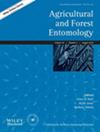Metabarcoding advances agricultural invertebrate biomonitoring by enhancing resolution, increasing throughput and facilitating network inference
IF 1.8
3区 农林科学
Q2 ENTOMOLOGY
引用次数: 0
Abstract



元条码通过提高分辨率、增加吞吐量和促进网络推断,推进农业无脊椎动物生物监测工作
由于我们需要了解:(a) 害虫和病原体对作物产量和健康的严重影响;(b) 环境变化和土地管理对昆虫的影响,以实现可持续发展和全球保护目标,因此对具有重要农业意义的昆虫进行生物监测变得越来越重要。传统的昆虫诱捕器仍然是生物监测工具箱的重要组成部分,但样本处理费时费力,而且准确性可能会有差异。将环境 DNA 和 DNA 元条码等分子技术整合到昆虫生物监测中的做法日益受到关注,但这样做的优势、可生成的数据种类以及如何将分子分析与目前使用的各种昆虫诱捕器轻松有效地整合在一起等问题仍相对不清楚。在这篇综述中,我们将探讨如何将 DNA 元条码与一系列常规和非常规的昆虫学取样技术相结合,以对研究人员和从业人员有用的方式推进生物监测工作。我们强调了一些关键挑战以及如何缓解这些挑战,并使用文献中不同取样方法(如拦截、坑阱和粘性诱捕器)的整合实例来证明其有效性和适用性。我们讨论了如何利用代谢条码数据来推断生态网络,强调了将其作为了解物种相互作用和生态系统功能框架的重要性,以便进行更有效的描述性生物监测。最后,我们还强调了生物监测的未来发展,并为使用元标码进行无脊椎动物生物监测的新手和经验丰富的研究人员提出了最佳实践建议。
本文章由计算机程序翻译,如有差异,请以英文原文为准。
求助全文
约1分钟内获得全文
求助全文
来源期刊

Agricultural and Forest Entomology
农林科学-昆虫学
CiteScore
3.60
自引率
6.20%
发文量
66
审稿时长
>24 weeks
期刊介绍:
Agricultural and Forest Entomology provides a multi-disciplinary and international forum in which researchers can present their work on all aspects of agricultural and forest entomology to other researchers, policy makers and professionals.
The Journal welcomes primary research papers, reviews and short communications on entomological research relevant to the control of insect and other arthropod pests. We invite high quality original research papers on the biology, population dynamics, impact and management of pests of the full range of forest, agricultural and horticultural crops.
 求助内容:
求助内容: 应助结果提醒方式:
应助结果提醒方式:


